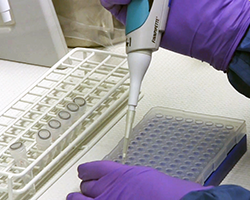Containing poliovirus and mitigating the risk of reintroduction in Europe

Sweden National Authority for Containment
Expanding the capacity of polio laboratories and improving coordination between them are crucial steps in global efforts to end poliomyelitis (polio), which was declared eradicated from the WHO European Region in 2002 and is endemic in only 2 remaining countries globally (Afghanistan and Pakistan). To review progress in the European Region and discuss next steps, representatives from 47 laboratories of the WHO European Regional Polio Laboratory Network (EPLN) located in 37 countries, as well as national poliovirus containment coordinators and representatives of national authorities for containment, came together in Copenhagen, Denmark on 24–26 September 2019.
The meeting provided updates on the development of new WHO guidelines on preventing and responding to a containment breach, on national preparedness plans and on poliovirus outbreak simulation exercises (POSE) conducted in the Region. WHO/Europe supports Member States in building laboratory capacities and conducting POSE to help ensure a quick and efficient national response in the event of a potential containment breach or importation of the virus.
Steps to contain poliovirus
To ensure that no poliovirus will re-emerge after global eradication, it is crucial to minimize the number of facilities holding samples of the virus and prevent any accidental release from such facilities. Among other steps, all 194 WHO Member States globally, as well as 21 non-member countries and territories, are currently engaged in the process of identifying, destroying or containing all poliovirus type 2 materials. Those Member States planning to retain poliovirus samples for vaccine manufacturing or critical research purposes in the future must apply for certification of a poliovirus essential facility (PEF), as well as establish a National Authority for Containment. As of 20 September 2019, 11 Member States in the European Region have expressed their intention to apply for certification of 1 or more PEFs.
Laboratory capacity-building
Most laboratories in the EPLN will not hold polioviruses in the future. However, all must be prepared to quickly, safely and accurately detect a poliovirus, to help minimize the potential spread among their populations in the event of a containment breach.
WHO therefore supports capacity-building of laboratories to implement virus intratypic differentiation (ITD), a technique that allows laboratories to differentiate between wild, vaccine and vaccine-derived polioviruses without the use of cell cultures, thereby reducing the risk of exposure and accidental release of the virus. Implementing ITD also enables faster sample-to-result turnaround and reduces the shipment of samples between countries.
“ITD reduces the need to grow the virus in cell culture. Removal of this step will greatly contribute to biorisk reduction and facilitate effective poliovirus containment in the WHO laboratories,” says Eugene Saxentoff, scientist, WHO/Europe.
As of September 2019, 36 out of the 47 EPLN laboratories have participated in platform- and language-specific training workshops and are now in different stages of ITD routine use.
Polio-free status of the WHO European Region
At its most recent meeting in May 2019, the European Regional Commission for Certification of Poliomyelitis Eradication (RCC) concluded that the European Region has sustained its polio-free status. However, 3 countries (Bosnia and Herzegovina, Romania and Ukraine) continue to be at high risk and 21 countries are at intermediate risk of experiencing an outbreak in the event of an importation, based on population immunity and/or quality of disease surveillance.



